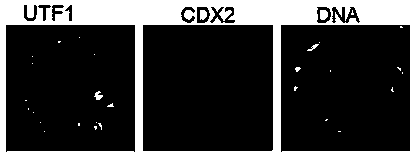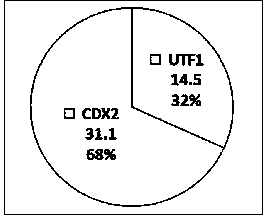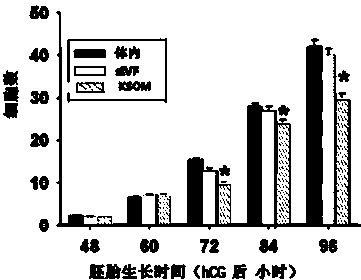Method for detecting quality of assisted reproductive technology by mouse embryo array
A technology of assisted reproductive technology and detection method, which is applied in the field of improved rat fetal test to detect the quality of assisted reproductive technology, can solve problems such as inability to identify culture conditions, and achieve the effects of improving in vitro growth and development and improving quality
- Summary
- Abstract
- Description
- Claims
- Application Information
AI Technical Summary
Problems solved by technology
Method used
Image
Examples
Embodiment 1
[0046]The present invention cultures the fertilized eggs of mice in several kinds of culture fluids commonly used in clinical practice at present, and analyzes the formation rate of blastocyst stage embryos and the number of cells of blastocysts, the total number of cells of embryos of different growth and development stages, and the positive results of blastocyst stage embryos. The number of cells expressing embryonic stem cell biological indicator UTF1 and trophoblast cells expressing CDX2. By comparing with the embryos that grew and developed at the same period, it can be clearly found that the fertilized eggs of mice grow in different culture solutions to produce embryos of different quality.
[0047] Mouse fertilized eggs need to meet the following conditions for embryo culture:
[0048] 1) Take 10 microliters of culture medium micro-droplets and cover them with about 2 mm thick mineral oil;
[0049] 2) 37°C constant temperature, moisturizing, and 5% O 2 + 5% CO 2 + ...
Embodiment 2
[0067] To compare and analyze the effects of culture medium commonly used in the market on blastocyst production rate and total cell number.
[0068] The fertilized eggs were cultured in KSOM, KSOM+AA and sIVF medium until 108 hours after hCG, and the embryo quality test was performed.
[0069] Fertilized egg culture: the culture conditions are 37°C constant temperature, moisture, and 5% O 2 + 5 % CO 2 + 90%N 2 The three in vitro culture fluids are KSOM commonly used in the market, KSOM + AA (KSOM added to contain all essential and non-essential amino acids) and sIVF (Sydney IVF culture fluid, including cleavage fluid and blastocyst fluid). Fertilized eggs are cultured in KSOM and KSOM+AA for 84 hours, and in sIVF culture medium, they are cultured in different stages, in the first 48 hours in cleavage fluid and then transplanted into blastocyst fluid. The embryo culture medium is compared with the sIVF embryo culture medium produced by COOK Company (this culture medium ...
Embodiment 3
[0072] Compared with the total cell number of embryos at the same time in vivo, the influence of the culture medium commonly used in the market on the total cell number of embryos at different growth and development stages was analyzed.
[0073] Divide the fertilized mice into three groups on the day when the suppository was seen, and collect the fertilized eggs in the two groups and culture them in KSOM and sIVF culture medium. 2 + 5 % CO 2 + 90%N 2 of mixed gas. In vivo contemporaneous embryos were collected from another group of mice. All three groups were assumed to be contemporaneous embryos at the same time after hCG injection. 48 hours after the injection of hCG, every 12 hours by using the "one-step cell counting kit" and detecting the total cell number of each embryo under a fluorescent microscope, and comparing the total cell number of the embryo in the culture medium with the total cell number of the embryo in the same period in vivo Compare. It was conclud...
PUM
 Login to View More
Login to View More Abstract
Description
Claims
Application Information
 Login to View More
Login to View More - R&D Engineer
- R&D Manager
- IP Professional
- Industry Leading Data Capabilities
- Powerful AI technology
- Patent DNA Extraction
Browse by: Latest US Patents, China's latest patents, Technical Efficacy Thesaurus, Application Domain, Technology Topic, Popular Technical Reports.
© 2024 PatSnap. All rights reserved.Legal|Privacy policy|Modern Slavery Act Transparency Statement|Sitemap|About US| Contact US: help@patsnap.com










